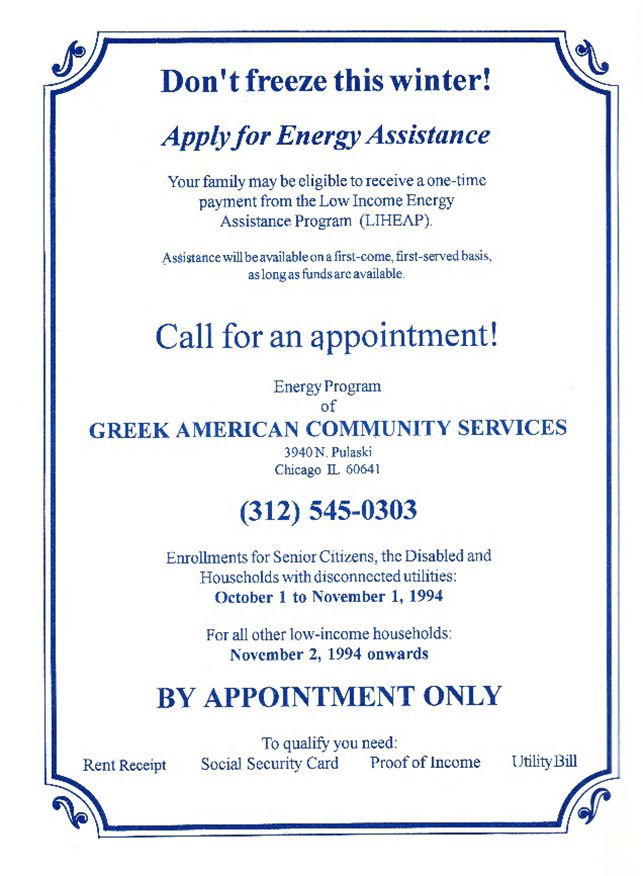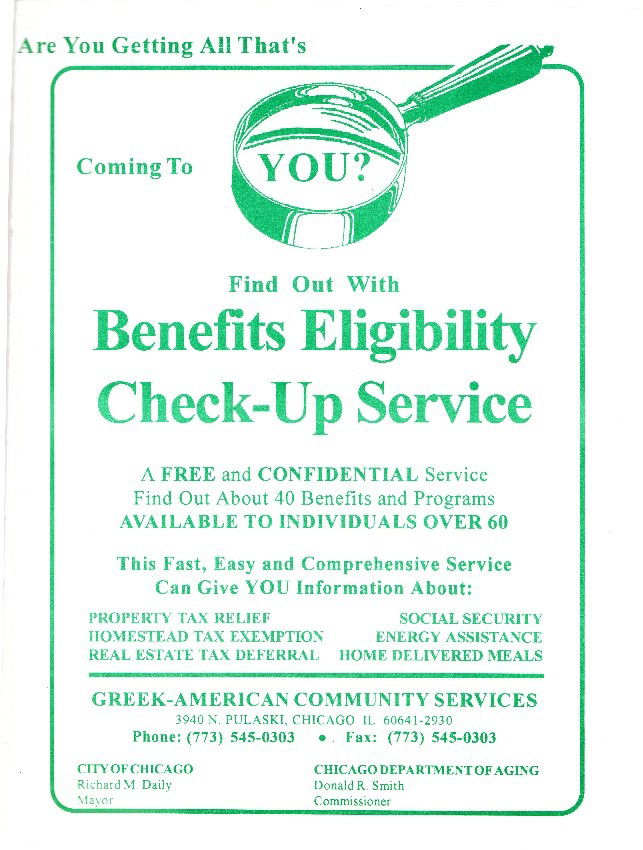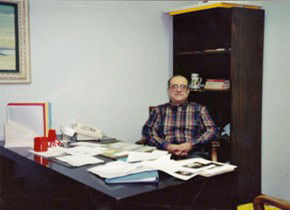Community Programs
From Working to Preserve Our Heritage: The Incredible Legacy of Greek-American Community Services
"Energy Assistance Program
In 1992, shortly after moving into our Pulaski office, we were approached by Michael Payne who coordinated north-side agencies for the Community Economic Development Agency of Cook County (CEDA). CEDA administered the federally funded Low-Income Home Energy Assistance Program (LIHEAP) in Cook County. LIHEAP assisted households with low incomes in paying for their heating expenses. In most cases, it was a credit that was applied to the recipient’s gas or electric company account. Some people received checks if, for example, their rent included utility costs.
CEDA was looking for a northwest-side intake site for this program. The program provided a stipend of $8 per approved application. Since clients needed to provide proof of their income, residency, and utility bills, which had to be copied and submitted with their application, CEDA provided us with a photocopy machine and a service agreement for the copier. This was before the days of the Internet and computers, and copy machines were vital office machines. Up until this point, GACS didn’t have a copy machine. We went to the corner to make copies for 10 cents a page, or to Kinkos or Easy Copy, for larger jobs. John R took on coordination of the LIHEAP program, enabling us to increase his hours with us. The process was detailed, and it took some time to complete an application. The first month (October) was limited to senior citizens, the disabled, or those who had their utilities disconnected. In November, enrollment opened for everyone else. The funds generally ran out in February.
We underestimated the response to this program when we first agreed to participate. Our initial plan was to have a first-come-first serve system on the days we offered the program. We ended up with a line of people waiting to be helped that went to the street and down Pulaski. Once in the center, some without warning, sat in with the adult day care clients or even helped themselves to food being served to adult day care participants.
We promptly put a halt to this. I was not comfortable with people off the street coming into contact with adult day care clients. Not only was it disruptive to activities, but it also caused confusion, noise, and some chaos. I was also concerned that we had no idea who these people were, and they might have posed a safety risk or health danger to those elderly who had weaker immune systems or were experiencing dementia. With all the coming and going, there was concern that an ADC client might find an opportunity to wander away unattended.
The first day of our new approach resulted in all five of our phone lines ringing nonstop all day long. No sooner would we hang up with one call, than another one came through. Maria, John, Ethel, Ann, and I did what we could to answer the calls and set appointments. Later that day I received a call from Illinois Bell, at that time our telephone utility, asking what was happening. The representative asked jokingly, “Are you giving away money or something?” It turned out that the volume of calls coming into GACS was so great that it overwhelmed the 545-telephone exchange, and some callers heard an “all circuits are busy” recording.
We quickly realized the need for this program was much larger than was anticipated, and we adapted as quickly as we could. We brought in a few people to help, trained them in how to complete the applications, and paid them a percentage of each application they prepared. They included Bob Blum, our van driver and activity aid, Kathy Rockaitis, a volunteer from the neighborhood, and Floyd “Red” Utley who helped with maintenance at the center. Nick Stathopoulos, a community volunteer, went through training as well. Since Nick was bilingual, our ability to help Greek-speaking applicants was enhanced. Before that, John was the sole Greek speaker in the mix.
At the end of each day, the applications and attachments were tabulated, collated, copied, and then assembled into batches. The emergency applications were prepared in red ink. Batch transmittal forms were completed, and the applications were picked up daily by a CEDA courier.
In our first year as an intake site for this program, we helped more than 1,600 households to apply for energy assistance and earned about $12,000 from this program. GACS continued to offer this program in future years with similar results. The same intake people continued their involvement throughout most of these years. Between July 12-16, 1995, Chicago experienced a record heatwave. The temperature had reached 106 degrees with very high humidity. This was on top of a warmer-than-usual July. The city was in crisis, and by the time the heatwave passed, there were 739 recorded deaths. Most were elderly or low-income individuals who did not have or could not afford the cost of air conditioning.
That summer, CEDA asked GACS to provide emergency cooling assistance. Just before the program began, a semi-trailer truck parked in front of our office to unload cases of box fans. We provided a fan to each applicant who needed one. Hundreds of people came to GACS during this period, and we were able to help them all. The crisis was exacerbated when an electric transformer serving the area caught fire, causing widespread power outages for several days during this heatwave. GACS was fortunate to have been on a different grid, so we were not impacted. but across the street from us, the power was out for several days. We opened as a cooling center during daytime hours and had several visitors through this outreach. We received large donations of fresh bagels from the Irving Park Community Food Pantry that we distributed to adult day care participants and LIHEAP clients.
Sadly, one of the casualties of this heatwave was Tina Beniaris. Tina was an older lady who was active within the Greek community, had been a GACS volunteer during special events, and was a participant in the Fabric Arts Project. She lived above George’s Restaurant on Foster Avenue near Kimball. She had come in a couple of days earlier to apply for LIHEAP benefits. Although the application had been submitted to CEDA for processing. it had not yet been approved. This underscored how vital this assistance was to those whom we served.
Benefits Eligibility Checklist Another program that operated under the GACS Community Services banner was the Benefits Eligibility Checklist (BEC), an outreach program that helped senior citizens (classified as age 60 and over) identify and apply for 40 governmental benefits and programs offered at the local, state, and federal levels for which they qualified. It was part of a national effort. The local program was funded by the Chicago Community Trust and the Retirement Research Foundation and was administered by the Chicago Department of Aging.
Among the financial assistance programs BEC screened for were: Qualified Medicare Beneficiary (QMB), Specified Low-Income Medicare Beneficiary (SLMB), Circuit Breaker Pharmaceutical Assistance, State Supplemental Payment (SSP), Supplemental Security Income (SSI), Social Security, Reverse Mortgage, Circuit Breaker Property Tax Relief, Homestead Tax Exemption, Real Estate Tax Deferral, Sewer Service Charge Exemption and Refund, and Railroad Pension. Energy assistance programs on the checklist were: Add-a-Dollar, Illinois Home Weatherization Program, Low Income Home Energy Assistance Program (LIHEAP), and the Illinois Telephone Connection Program. The nutrition/meal programs available were the Food Stamp Program, Golden Diners, and Home Delivered Meals.
Health care programs covered were Illinois Comprehensive Health Insurance Plan (CHIP), Medical Assistance – No Grant (MANG), Health care programs were Illinois Comprehensive Health Insurance Plan (CHIP), Medical Assistance – No Grant (MANG), Medicare, Medicare Part A, Medicare Part B, Total-Dent, Dentistry for the Homebound, Emergency Response System, National Eye Care Project, and Public Health Clinics. Housing resources BEC screened for were CHA Senior Housing, Subsidized Housing for Low-Income Seniors, Home Repairs for Accessible Living (H-RAIL), and the Homescape Program. Legal assistance programs were Living Will, Durable Power of Attorney for Health Care, and the Community Spousal Impoverishment Program. In-home services offered were the Community Care Program (CCP) and Respite Care Program. The transportation programs they screened for were CTA/RTA Reduced Fare Program, Chicago Taxi Access Program (TAP), Reduced Auto Insurance, and Reduced City vehicle stickers. Employment resources included: The Job Training Partnership Act (JTPA), Operation ABLE, and the Senior Community Service Employment Program (SCSEP) –Title V.
In the early days of BEC, a concerted effort was made to reach limited and non-English speaking elderly. They were least likely to be aware of programs and services that they were qualified to receive. In addition to language and cultural barriers, this population was difficult to reach and was often insular. In some cases, they shunned mainstream media or had a fear or distrust of the government due to life experiences they encountered in their homeland.
As a result of the relationship we enjoyed with CDOA, and our expertise in working with both the Greek community and older adults on the northwest side, we were invited to take part in this program in a unique way. CDOA agreed to pay a part-time Greek-speaking outreach worker to be housed at our center. This person would reach out to older adults to complete the BEC checklist and identify any benefits, services, or entitlements that the senior might qualify for. To my knowledge, GACS was the only ethnic organization to have this sort of arrangement with CDOA at the time.
John agreed to take on this role. At the time he was substitute teaching and was able to work with us on days he didn’t get called in. John worked about 20 hours per week at GACS overseeing our Cultural and Arts Program and the publicity for GACS. Additionally, during certain times of the year, he coordinated the LIHEAP program. The new arrangement allowed John to work full-time at GACS. Half of his time was spent on BEC, and the other half focused on other responsibilities. This arrangement with the city continued for a couple of years. In addition to the low-hanging fruit of our clients, John did outreach events at Greek church picnics, city festivals, area businesses, community events, and partnerships with other organizations. In all we helped hundreds of seniors, possibly thousands, to learn about and receive benefits that they were qualified for and entitled to receive. We created and translated outreach fliers in Greek that were distributed to the churches and other community gathering places. Publicity in both the Greek and local media regularly occurred.
Two of the main program areas under the Community Services Program banner were supervised by John (LIHEAP and BEC). It ended up that in addition to the Cultural & Arts Program, John oversaw most of our community programs. Annually, the community service programs assisted more than 1,500 clients. This was in addition to the adult day care center participants and the Community Aging Network clients. Depending on the types of programming being offered in any given year, the Cultural and Arts Program reached over 1,000 and, in some years, more (not including the thousands who viewed our traveling exhibit). It is fair to say that GACS reached thousands of people each year in a variety of ways.
A couple of years later, CDOA required John to work from the Copernicus Center, which was the department’s Northwest regional office. He often participated in outreach activities at grocery stores, community events, and other public venues. During excessive heat or cold days, John was deployed, along with most CDOA personnel, to do well-being checks on seniors."

Advertisement for the Low Income Home Energy Assistance Program (LIHEAP). Circa 1994. John Psiharis collection.

Advertisement for the Benefits Eligibility Checklist (BEC) program. Circa 1995. John Psiharis collection.

John Psiharis and Chicago Department On Aging commissioner Donald Smith aboard the Odyssey at Navy Pier. Date unknown. John Psiharis collection.

John Rassogianis in his first-floor office at Greek-American Community Services. Date unknown. John Psiharis collection.